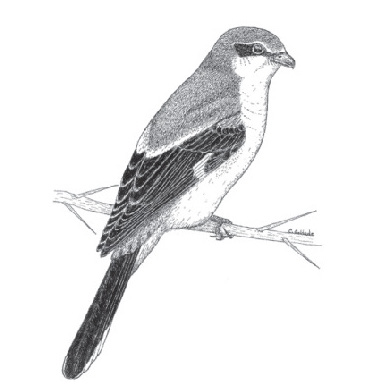Not long ago, during a jobless stint I spent at my sister’s house in Texas, I came across a small lizard impaled on a thornbush. Its head was flattened, its torso ripped open and viscera all asunder. Understandably, it wore a haggard expression on its face, or what was left of its face. “Hey,” I said to my sister Erin, who was planting azaleas in her garden. “Who crucified this lizard?”
Erin wiped her hands on her shorts and walked over. “That’s a frog,” she said, an eyebrow incredulously arched.
The thing was so mangled it was hard to tell what it was. Clearing her throat, Erin laid out the case: the crucifixion was likely the work of an avian called the Loggerhead Shrike, also known as the Butcher Bird, or, she went on, Lanius ludovicianus. About the size of a robin, the Butcher Bird impales its prey—frogs, mice, snakes, and, yes, even lizards—on thornbushes, cactus spines, and the like, and then uses its hard, hooked beak to disembowel said prey, often leaving the carcass to dry out in the sun like jerky.
The Butcher Bird, it turns out, is not a sadist, or not merely so. It lacks the powerful talons of other birds of prey such as hawks, vultures, and college coeds with which to hold its victims in place while eviscerating them. Hence the thornbush trick, which my field guide referred to as “an ingenious adaptation.” The Butcher Bird also has a “cutting tooth” in its upper beak that it uses to sever the spinal cords of its vertebrate quarry, paralyzing and, one hopes, sparing them some discomfort.
Butcher Birds breed primarily in the northern U.S. and Canada but spread their terror south into Mexico and as far east as Virginia, stalking grasslands, farms, and places like the abandoned golf course beyond my sister’s backyard.
I wanted to see a Butcher Bird for myself, and so, armed with binoculars, I spent an afternoon canvassing the golf course for the beast’s distinctive white belly and Hamburglar-like mask. I expected to see them flitting all about on their murderous errands well provisioned with frog corpses. Several times I heard the Butcher Bird’s chilling warble in the distance—queedle queedle—but it refused to show itself. The daytime sky in Texas is an apocalypse, so menacingly bright it’s hard to take for very long, which must present an advantage to winged predators. My own retinas were wobbling from the effort.
Finally, just as I was about to give up, a Butcher Bird appeared. I watched it flap from branch to branch, carefully eyeing the terrain, when suddenly it turned and looked right at me. For several moments it held my gaze. My heart gulped. I braced for its charge. Instead, it swooped to a patch of grass on what used to be the eleventh hole, seized a tiny creature in its beak, and swiftly bayoneted it onto the same thornbush as before. Mouth agape, I watched the poor thing wriggle and gasp in its death throes. The Butcher Bird went about its grim business and winged off.
Upon closer inspection, the creature turned out to be a lizard. Of this I was certain. Its green leathery body was unmistakably lizard-like, with the inimitable forked tongue clamped between its jaws. Its intestines, naked to the world, shone like cooked spaghetti.
I called my sister over. As she inspected the scene, I began to feel a grudging respect for the Butcher Bird. To see an animal overcome its genetic shortcomings in such dramatic fashion, supported by a brain the size of a lentil, well, it gives a man hope.
Butcher Bird numbers are declining in North America, mostly due to what conservationists charitably call “changing human land-use practices,” another way of saying Butcher Bird habitat is being replaced by Home Depots. Glass patio doors probably have something to do with it, too, and hoodlum children with pellet guns.





